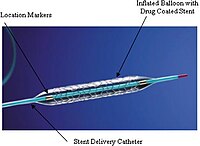
Photo from wikipedia
Objective In this retrospective study, we aimed to observe the efficacy of pericardial effusion (PE) treatments by a survey conducted at the Department of Cardiovascular Surgery, Faculty of Medicine, Atatürk… Click to show full abstract
Objective In this retrospective study, we aimed to observe the efficacy of pericardial effusion (PE) treatments by a survey conducted at the Department of Cardiovascular Surgery, Faculty of Medicine, Atatürk University. Methods In order to get comparable results, the patients with PE were divided into three groups - group A, 480 patients who underwent subxiphoid pericardiostomy; group B, 28 patients who underwent computerized tomography (CT)-guided percutaneous catheter drainage; and group C, 45 patients who underwent echocardiography (ECHO)-guided percutaneous catheter drainage. Results In the three groups of patients, the most important symptom and physical sign were dyspnea and tachycardia, respectively. The most common causes of PE were uremic pericarditis in patients who underwent tube pericardiostomy, postoperative PE in patients who underwent CT-guided percutaneous catheter drainage, and cancer-related PE in patients who underwent ECHO-guided percutaneous catheter drainage. In all the patients, relief of symptoms was achieved after surgical intervention. There was no treatment-related mortality in any group of patients. In patients with tuberculous pericarditis, the rates of recurrent PE and/or constrictive pericarditis progress were 2,9% and 2,2% after tube pericardiostomy and ECHO-guided percutaneous catheter drainage, respectively. Conclusion Currently, there are many methods to treat PE. The correct treatment method for each patient should be selected according to a very careful analysis of the patient's clinical condition as well as the prospective benefit of surgical intervention.
Journal Title: Brazilian Journal of Cardiovascular Surgery
Year Published: 2019
Link to full text (if available)
Share on Social Media: Sign Up to like & get
recommendations!